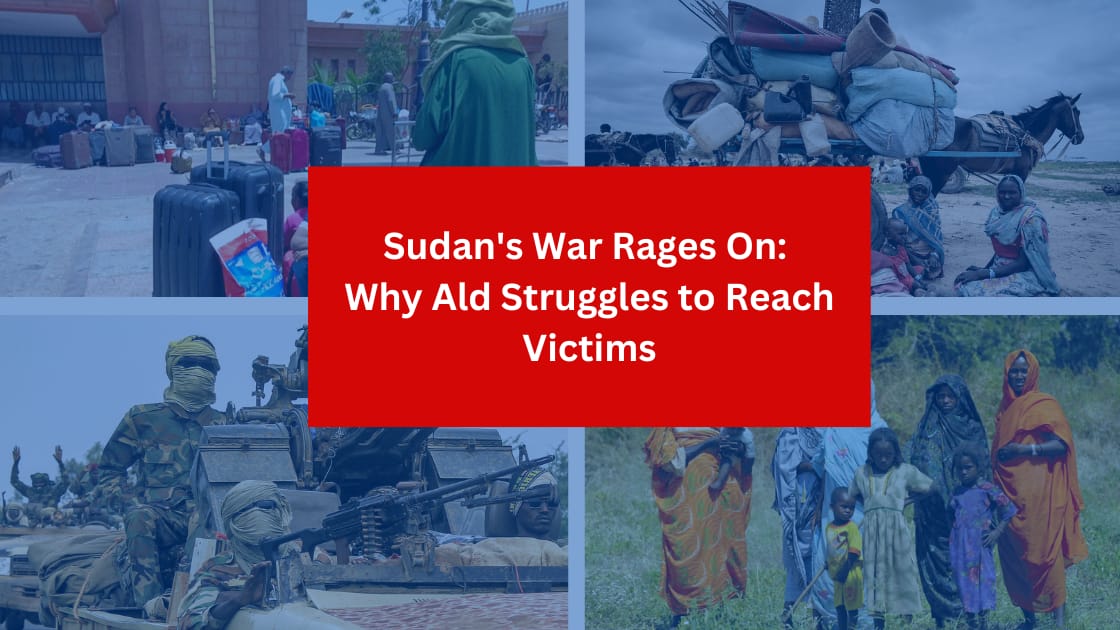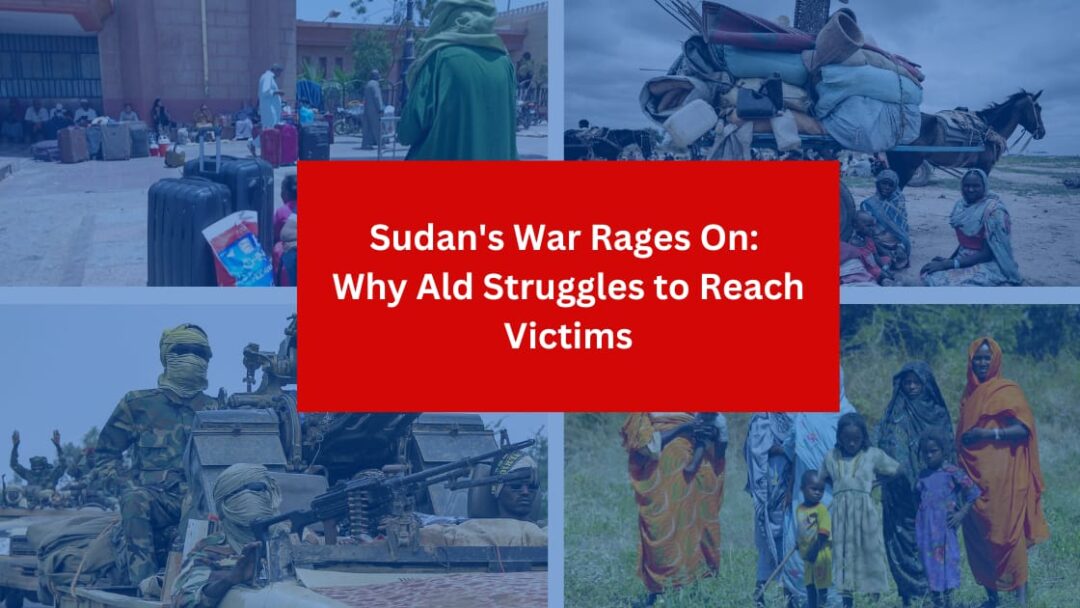Physical Address
304 North Cardinal St.
Dorchester Center, MA 02124

Introduction:
Sudan’s War Rages On, a country with a rich history and strategic importance in Africa, has been embroiled in a devastating war that continues to escalate. The ongoing conflict, which began in April 2023 between rival military factions, has plunged the nation into chaos, leaving thousands dead and millions displaced. Despite numerous attempts at ceasefire agreements and international calls for peace, the violence persists.
Humanitarian aid organizations face immense challenges in delivering much-needed assistance to the victims of the conflict. The war has turned once-thriving cities into battlegrounds, and civilians are caught in the crossfire. This article delves into the complexities of Sudan’s War Rages On, the key players involved, and the reasons why humanitarian aid struggles to reach those in need.
Sudan’s War Rages On current conflict can be traced back to long-standing political and ethnic tensions, exacerbated by economic instability and power struggles within the military. After the ousting of long-time dictator Omar al-Bashir in 2019, hopes were high for a democratic transition. However, Sudan’s fragile interim government, which comprised both civilian and military leadership, was rife with divisions. These tensions culminated in the outbreak of open conflict in 2023 between Sudan’s two most powerful military leaders: General Abdel Fattah al-Burhan, head of the Sudanese Armed Forces (SAF), and General Mohamed Hamdan Dagalo, commonly known as Hemedti, leader of the paramilitary Rapid Support Forces (RSF).
The Role of the Sudanese Armed Forces (SAF): The SAF has traditionally been the dominant military power in Sudan’s War Rages On, with strong connections to the state’s bureaucracy and international actors. Under the leadership of al-Burhan, the SAF has positioned itself as the protector of Sudan’s territorial integrity and sovereignty. However, it has faced accusations of human rights abuses and repression, especially during Sudan’s various internal conflicts.
The Rapid Support Forces (RSF): Originally formed from the notorious Janjaweed militias, which were involved in atrocities during the Darfur conflict, the RSF has evolved into a powerful paramilitary force. Hemedti has built a network of alliances, particularly in Sudan’s peripheries, where the RSF is seen as a defender of marginalized groups. Despite its role in fueling violence in Darfur, the RSF has garnered significant political and military clout.
The conflict between the SAF and RSF has quickly escalated into a nationwide war, with neither side showing signs of compromise. Both factions seek control of key cities, including the capital, Khartoum, and vital economic resources such as gold mines and oil fields.
The human toll of Sudan’s War Rages On war aid is staggering. According to reports from the United Nations and humanitarian organizations, the conflict has resulted in over 9,000 deaths and displaced more than 5 million people, many of whom have fled to neighboring countries such as Chad, Egypt, and South Sudan. Additionally, millions of Sudanese civilians are now facing acute food insecurity, as the war has disrupted supply chains and agricultural production.
The war has devastated Sudan’s War Rages On infrastructure, including hospitals, schools, and markets. Major cities, including Khartoum, have become battlegrounds, with civilians enduring constant shelling, airstrikes, and armed clashes. The widespread violence has led to an urgent need for humanitarian assistance, yet Sudan war aid agencies have found it increasingly difficult to deliver food, medicine, and other essential supplies to those most affected by the conflict.
The ongoing war in Sudan’s War Rages On has created a host of challenges for humanitarian organizations attempting to provide Sudan war aid to the country’s most vulnerable populations. Several key factors have contributed to the difficulty of delivering assistance:
One of the most significant obstacles to humanitarian operations in Sudan is the pervasive insecurity and violence directed at Sudan’s War Rages On aid workers. Both the SAF and RSF have been accused of deliberately targeting humanitarian convoys and facilities. In some cases, Sudan War aid workers have been caught in the crossfire, leading to tragic fatalities. The conflict has also seen the looting of warehouses, vehicles, and supplies by both military factions and armed criminal groups, further hampering relief efforts.
In April 2023, the World Food Programme (WFP) suspended its operations in Sudan’s War Rages On after three of its staff members were killed during clashes in the western part of the country. While some aid organizations have resumed operations, the environment remains extremely dangerous, with limited guarantees of safety for aid workers. The lack of security means that many international aid organizations are reluctant to operate in conflict zones, leaving vast areas of Sudan without any meaningful assistance.

Even in areas where the security situation is relatively stable, humanitarian organizations face significant bureaucratic and logistical challenges in delivering Sudan War aid. Both the SAF and RSF have imposed numerous restrictions on the movement of aid convoys, often requiring permits and clearances that can take weeks or months to obtain. These restrictions are frequently used as political leverage, with each faction attempting to control the flow of aid to areas under their influence.
In addition to bureaucratic delays, many regions of Sudan’s War Rages On are inaccessible due to the destruction of infrastructure such as roads, bridges, and airports. The war has severely disrupted transportation networks, making it difficult for aid organizations to reach remote or isolated communities, particularly in conflict-ridden areas like Darfur and the Nuba Mountains.
Sudan’s War Rages On healthcare system, already fragile before the war, has collapsed under the weight of the ongoing conflict. Hospitals and clinics have been damaged or destroyed, and medical staff have fled or been killed. The lack of functioning healthcare facilities has made it nearly impossible for aid organizations to provide essential medical care to those affected by the conflict.
In addition to the destruction of healthcare infrastructure, there is a severe shortage of medical supplies, including life-saving drugs, vaccines, and surgical equipment. Humanitarian agencies have struggled to deliver these supplies to hospitals and clinics, particularly in besieged areas like Khartoum, where ongoing fighting has cut off access to medical facilities. The lack of clean water and sanitation services has also contributed to the spread of diseases such as cholera and malaria, further exacerbating the humanitarian crisis.
The war has triggered a massive internal displacement crisis, with millions of Sudanese forced to flee their homes. Internally displaced persons (IDPs) face dire living conditions, often residing in overcrowded camps or makeshift shelters with limited access to food, clean water, and healthcare. These IDP camps are frequently located in conflict zones, making them difficult to reach for aid organizations.
The conflict has also created a refugee crisis, with over 1 million Sudanese seeking refuge in neighboring countries. The influx of refugees has overwhelmed border regions and refugee camps in Chad, Egypt, and South Sudan’s War Rages On, where resources are already stretched thin. Humanitarian organizations working in these border areas face challenges in providing adequate support to the growing number of refugees, many of whom arrive malnourished and traumatized by the violence.
One of the most complex challenges for humanitarian aid efforts is the fragmentation of the warring parties. The SAF and RSF are not monolithic entities; both have splinter groups, local militias, and criminal gangs that operate with varying degrees of autonomy. This fragmentation complicates efforts to negotiate safe passage for aid convoys, as different factions control different territories and often have conflicting interests Sudan’s War Rages On.
In many cases, humanitarian organizations are forced to navigate a patchwork of checkpoints and armed groups, each demanding bribes or imposing arbitrary conditions on the delivery of Sudan’s War Rages On Rages On aid. The lack of centralized authority and the proliferation of armed actors has created a chaotic and dangerous environment for aid workers, further restricting the ability to deliver assistance to those in need.
The international community has responded to the crisis in Sudan’s War Rages On with a mix of humanitarian Sudan’s War Rages On aid, diplomatic pressure, and sanctions. The United Nations, through its various agencies, has been at the forefront of relief efforts, coordinating with NGOs and local partners to provide food, water, medical care, and shelter to displaced populations. However, the scale of the crisis has overwhelmed these efforts, and funding shortfalls have hampered the ability to meet the growing needs.
In addition to humanitarian assistance, the international community has attempted to mediate peace talks between the warring factions. Several ceasefires have been brokered, most notably by the African Union (AU) and the United States. However, these ceasefires have been repeatedly violated, with both sides blaming each other for the breakdown in negotiations. The lack of sustained international pressure and the deep mistrust between the SAF and RSF have made it difficult to achieve a lasting peace agreement.
Sanctions have also been imposed on Sudanese military leaders in an attempt to pressure them into ending the conflict. The U.S. and European Union have targeted individuals and entities linked to both the SAF and RSF, freezing assets and restricting travel. However, these measures have had limited impact, as the warring factions continue to receive support from regional actors, including the United Arab Emirates and Egypt, who have vested interests in the outcome of the conflict.
As Sudan’s War Rages On, the humanitarian situation is likely to worsen unless significant changes are made to address the challenges faced by aid organizations. Several steps can be taken to improve the delivery of aid and alleviate the suffering of Sudan’s civilian population:
The war in Sudan shows no signs of abating, and the humanitarian crisis continues to deepen. The challenges faced by Sudan’s War Rages On war aid organizations in delivering assistance to the victims of the conflict are immense, but not insurmountable. With sustained international pressure, improved security conditions, and increased funding, it is possible to mitigate the suffering of Sudan’s civilian population. However, the path to peace will be long and difficult, and it will require the concerted efforts of both Sudanese leaders and the international community to bring an end to the violence and pave the way for a brighter future for Sudan’s War Rages On.
[…] of the most pressing issues in the 2024 US Elections is the economy, particularly inflation and the rising cost of living. In the years leading up to […]